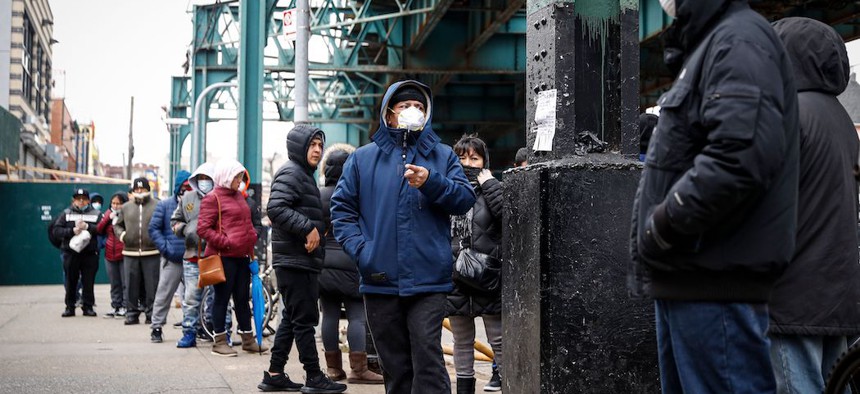News about COVID-19 in New York is bleak. A rising number of cases and deaths, financial havoc, social isolation and uncertainty have made many residents feel understandably anxious during this time.
Soon, that could become a public health crisis of its own. Experts around the country have already begun to see spiking anxiety and other forms of emotional distress and they are bracing for increased mental health problems.
In New York, which has become the epicenter of the pandemic in the United States, those mental health problems will likely be particularly acute. “The general public is going to be traumatized,” said Harvey Rosenthal, CEO of the New York Association of Psychiatric Rehabilitation Services, which represents community-based mental health providers, comparing the incoming anxiety with the one that affected New Yorkers in the aftermath of the attacks of 9/11.
Though the government-ordered lockdowns to slow the virus’ spread affect everyone, different communities will face different concerns. Many older adults, especially those who live alone, may already have mental health problems stemming from lack of social connection. That is sure to worsen now that spending time with family and friends is prohibited and public meeting places such as restaurants and senior centers are closed. People with pre-existing mental health or substance abuse problems may be more likely to relapse in this stressful time. For New Yorkers who are losing jobs, the stress of where to find their next meal and support their families will cause a different source of mental health problems.
“Mental health kind of overlays and connects with everything that's going on around us right now,” said Matt Kudish, executive director of the National Alliance on Mental Illness New York City.
Addressing those rising concerns comes with demand for both individual and collective action, mental health professionals have said. Mental health groups have started a new “Strive for Five” campaign to encourage people to identify five people in their life that they will check-in with daily over the next 30 days to tackle depression and anxiety associated with distance. Limiting intake of social media and news, while making sure you get exercise, have also been encouraged by mental health professionals.
Professional mental health support in the meantime has also largely shifted to digital therapy sessions, peer support groups and other forms of check-ins online or by phone. The National Alliance on Mental Illness New York City has shifted many of its support groups to phone or open online conferences and plans on creating a new group for people to share their concerns about the coronavirus. Some organizations are creating texting groups. Many have expanded their operating hours, even transitioning to 24/7 hotlines and other services.
“This takes a trend that was already fast on the move, and just puts it on steroids,” Rosenthal said.
He said the shift is good, particularly if it carries on after the coronavirus outbreak slows, given that it gives geographic flexibility and may allow providers to reach people in new innovative ways. However, poor access to technology may hamper those efforts. Cal Hedigan, who leads Community Access, a nonprofit which operates housing and other social services for people with mental health needs, has had to place an order for hundreds of phones for their clients so they can continue to get varying support.
Traditionally, access to professional therapy has often been hampered because it is costly and not everyone has insurance that will pay for it. In response, Gov. Andrew Cuomo has called on therapists, psychologists and other mental health professionals to volunteer their time so the state can begin to provide free, remote mental health services in the future. Though the details have yet to be fleshed out, Lisa Furst, assistant vice president of the Center for Advocacy, Policy and Education with Vibrant Emotional Health, had praise for the initiative’s goals.
“I think there are a lot of people that actually want to offer their services,” she said. “And we've been hearing that from providers even locally, how can I help? How can I make myself a service? How can I volunteer?”
One concern for mental health professionals might be if they are opening themselves up to legal liability, as their malpractice insurance doesn’t cover volunteer efforts, but the federal stimulus package that is expected to soon be enacted is likely to include an indemnification from liability for medical care providers who volunteer during the coronavirus outbreak. Many psychologists and psychiatrists may also be unsure of where and how they can go about volunteering. Videoconferencing technology does mean, however, that counseling and therapy can mostly be done remotely, and safely, during the pandemic.
State Sen. David Carlucci, who heads the Senate’s Committee on Mental Health and Developmental Disabilities, called on government officials and mental health professionals to step up in response.
“Obviously, we need the commissioner of the state Office of Mental Health to play an integral role,” he told City & State. “We need the associations of all the medical professionals to really play the lead here and say what will work and what won't work. This is being built on the go, but we have technology in place. We have the workforce that can really step up and fill this need.”


